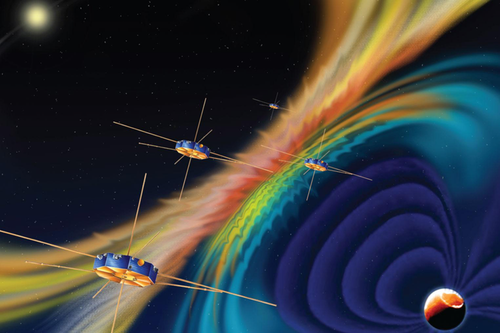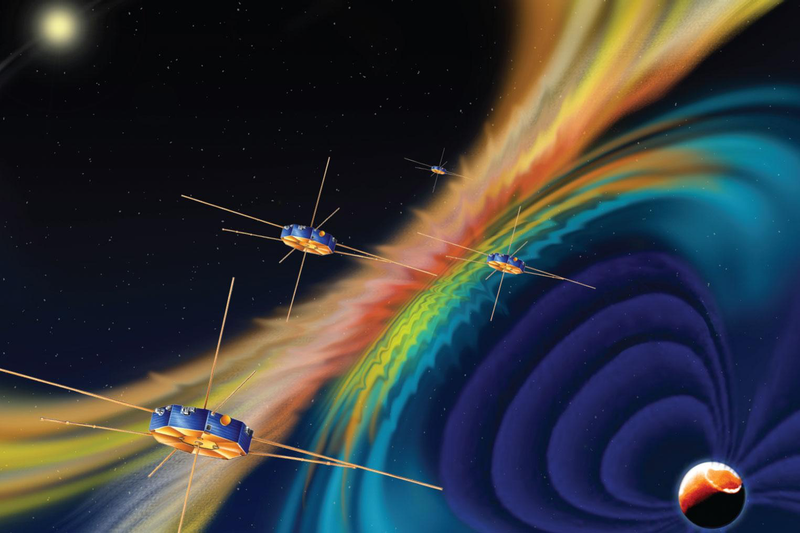Space Wave Gives Electrons a Shove
Charged particles around the Earth, Sun, and other astrophysical bodies appear to be accelerated to high energies in regions where magnetic fields break up and reconnect, but the exact mechanism is unclear. A recently launched multi-satellite mission has now flown through such a region and directly observed electron acceleration by fast-moving electric-field waves, suggesting a possible role for these waves in the production of high-energy particles. The new data may be an important step in unraveling the mysteries behind solar flares and other energetic cosmic events.
To learn about the strong interactions between particles and magnetic fields that occur near many planets and stars, researchers study the magnetopause, where the solar wind meets the Earth’s magnetic field. The solar wind is a collection of mostly protons and electrons streaming out from the Sun, carrying with it the interplanetary magnetic field (IMF), which spirals outward from the Sun. Within the magnetopause, the IMF and the geomagnetic field often point in nearly opposite directions in a region called the X-line. The field misalignment forces the field lines to break and reconnect. This reconnection, which also occurs around the Sun and in other plasma regions, converts magnetic energy into kinetic energy for charged particles. Studying reconnection is important for understanding the generation of high-energy particles around the Earth (which endanger satellites and high-altitude airplane passengers) and also for explaining high-energy events like solar flares.
Acceleration of electrons in a reconnection region has been much harder to measure than the acceleration of ions. Forrest Mozer of the University of California, Berkeley, and his colleagues now report on a direct observation of electron acceleration occurring in the magnetopause, using the Magnetospheric Multiscale (MMS) mission. Launched in the spring of 2015, MMS consists of four satellites flying in a tetrahedral formation. Each probe records electric and magnetic fields as well as the numbers of electrons and ions in various energy ranges. Compared with other multi-satellite missions, the MMS probes have a smaller separation (as little as 10 km), which affords them much higher spatial resolution for measuring localized acceleration mechanisms in reconnection regions.
On October 5, 2015, the MMS flotilla was passing the X-line in the dayside magnetopause. Two of the probes recorded a set of sharp spikes in the electric field pointing parallel to the local magnetic field. The spikes were part of a traveling wave called a time domain structure (TDS). TDSs have been detected many times by satellite missions in other regions [1]. They have not generally been considered as acceleration mechanisms because the electric field in a spike has both positive (push) and negative (pull) peaks, giving a net electric potential of only 10 volts or less. “They were thought to be the result of some other processes rather than significant mechanisms on their own,” Mozer says.
However, a TDS can accelerate particles because it acts like a fast-moving barrier that “bumps into slow-moving electrons,” Mozer explains. By comparing the spike arrival times at the two MMS spacecraft, he and his colleagues were able to directly measure the velocity of a TDS, whereas previous TDS observations could only infer the velocity. They found that the wave was moving away from the X-line at 4000 km/s. The MMS instruments confirmed that the wave led to particle acceleration by observing a 50% jump in the number of modestly-high-energy electrons after the wave’s passing. The TDS boosted electrons to around 200 eV, 40 times their initial energy.
This is not the first detection of TDS-induced acceleration [2], but it is the first direct observation of electron acceleration by TDS within a reconnection region. Mozer admits that the energy gain is not enough to explain 100-keV electrons that have been observed in other reconnection zones. But he believes that faster moving TDSs may be observed in the future. “I think we are seeing just the tip of the iceberg,” Mozer says.
The MMS observations are new and significant because they are “able to characterize TDSs and directly investigate the associated particle acceleration simultaneously,” says Daniel Graham of the Swedish Institute of Space Physics. James Drake of the University of Maryland says the acceleration “was more than you might expect for such a small electric field.” Still, the total energy gain is not very large, so other mechanisms may play a dominant role in accelerating electrons. Even so, Drake believes these new observations are important for providing benchmarks for computer simulations of reconnection regions.
This research is published in Physical Review Letters.
–Michael Schirber
Michael Schirber is a Corresponding Editor for Physics Magazine based in Lyon, France.
References
- F. S. Mozer, O. V. Agapitov, A. Artemyev, J. F. Drake, V. Krasnoselskikh, S. Lejosne, and I. Vasko, “Time Domain Structures: What and Where They Are, What They Do, and How They Are Made,” Geophys. Res. Lett. 42, 3627 (2015).
- F. S. Mozer, O. Agapitov, V. Krasnoselskikh, S. Lejosne, G. D. Reeves, and I. Roth, “Direct Observation of Radiation-Belt Electron Acceleration from Electron-Volt Energies to Megavolts by Nonlinear Whistlers,” Phys. Rev. Lett. 113, 035001 (2014).





